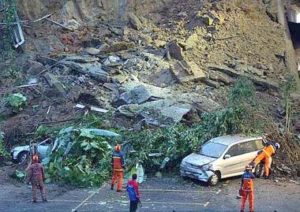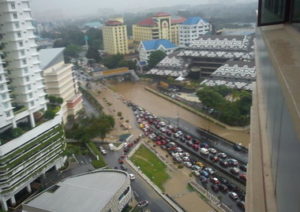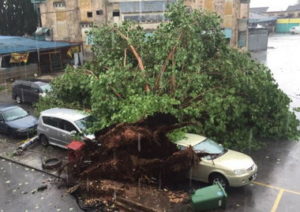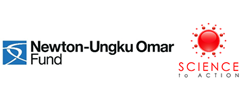Disaster Resilient Cities
Forecasting Local Level Climate Extremes and Physical Hazards for Kuala Lumpur
Search Posts
About
 Recent disasters in Malaysia have revealed poor coordination and weak capacity with regard to the prediction of floods and landslides, and there is also concern over the occurrences of strong winds, air pollution (haze) and extreme temperatures. Development of forecasting capacity for these events is now important for major cities, particularly in view of climate change. The aim of this international project is to customise climate and hazard models from the UK to forecast physical hazards common in Kuala Lumpur i.e. flash floods and floods, landslides, sinkholes, strong winds, urban heat and local air pollution; to test their viability; to develop a prototype multi-hazard platform for managing and communicating the risks of damaging events to enhance disaster resilience; and to promote the platform through outreach and marketing.
Recent disasters in Malaysia have revealed poor coordination and weak capacity with regard to the prediction of floods and landslides, and there is also concern over the occurrences of strong winds, air pollution (haze) and extreme temperatures. Development of forecasting capacity for these events is now important for major cities, particularly in view of climate change. The aim of this international project is to customise climate and hazard models from the UK to forecast physical hazards common in Kuala Lumpur i.e. flash floods and floods, landslides, sinkholes, strong winds, urban heat and local air pollution; to test their viability; to develop a prototype multi-hazard platform for managing and communicating the risks of damaging events to enhance disaster resilience; and to promote the platform through outreach and marketing.
The consortium assembled to achieve these goals consists of 16 research and business organisations; 6 from the UK and 10 from Malaysia. Primary beneficiaries will be decision-makers in local government and the insurance sector. The system will have wide application in cities across the ASEAN region.
- Project duration: Jan 2017 – Oct 2019
- Funders: MIGHT (Malaysia), InnovateUK (UK)
- Project leaders: Prof. Joy Pereira (Malaysia), Prof. Julian Hunt (UK)



Project Partners:
Malaysia Partners
- SEADPRI, Universiti Kebangsaan Malaysia, UKM
- Department of Geology, University of Malaya, UM
- Malaysian Meteorology Department, MMD
- Department of Mineral and Geoscience of Malaysia, JMG
- Department of Environment Malaysia, DoE
- UKM Pakarunding Sdn. Bhd., UKMP
- Geomapping Technology Sdn. Bhd., GMT
- Param Agricultural Soil Surveys (M) Sdn. Bhd, PASS
- Geological Society of Malaysia, GSM
- CoRE Expert Systems Sdn. Bhd., CES
UK partners
Steering Committee:
- Kuala Lumpur City Hall (DBKL)
- Malaysian Industry-Government Group for High Technology (MIGHT)
- Ministry of Federal Territories (KWP)
- National Disaster Management Agency (NADMA)
- Department of Town and Country Planning (PLANMalaysia)
- Department of Irrigation and Drainage (JPS)
- National Hydraulic Research Institute of Malaysia (NAHRIM)
- Malaysia Civil Defence Force (APM)
- Public Works Department (JKR)
List of meetings held:
Year 2018:
- NUOF BGS-JMG ODA Geoscience for Sustainable Meeting 1/2018, 5 Jan 2018
- UK Q4 Project Team Meeting with Innovate UK, 24 Jan 2018
- Geophysical Hazards Group Meeting 1/2018, 23 Jan 2018
- UK Q4 Project Team Meeting with Innovate UK, 24 Jan 2018
- Meteorology Parameter Group Meeting 1/2018, 29 Jan 2018
- Atmospheric Hazard Skype Meeting 1/2018, 2 Feb 2018
- Geophysical Hazards Group Meeting 2/2018, 6 Feb 2018
- World Urban Forum 9, 7-13 February 2018
- Project Steering Committee Meeting 1/2018, 1 Mar 2018
- Geophysical Hazards Group Meeting 3/2018, 2 Mar 2018
- Atmospheric Hazard Skype Meeting 2/2018, 13 Mar 2018
- Atmospheric Hazard Skype Meeting 3/2018, 4 Apr 2018
- Malaysia Project Team Meeting 1/2018
- Atmospheric Hazard Skype Meeting 4/2018, 24 Apr 2018
- UK Q5 Project Team Meeting with Innovate UK
- Malaysia Project Team Meeting 2/2018
- Project Steering Committee Meeting 2/2018
- Steering Committee Meeting Chaired by DBKL 1/2018
- Submission of the Interim Narrative and Financial Report, 30 June 2018
- UK Q6 Project Team Meeting with Innovate UK
- Malaysia Project Team Meeting 3/2018
- Project Steering Committee Meeting 3/2018
- UK Q7 Project Team Meeting with Innovate UK
- Malaysia Project Team Meeting 4/2018
- Project Steering Committee Meeting 4/2018
- Steering Committee Meeting Chaired by DBKL 2/2018
Year 2017:
- Project Steering Committee Meeting 1/2017, 20 Jan 2017
- Courtesy Call to MMD, 27 Jan 2017
- UK Project Team Meeting 1/2017, 31 Jan 2017
- Steering Committee Meeting Chaired by DBKL 1/2017, 6 Feb 2017
- Geophysical Hazard Meeting 1/2017 in UK, 17 Feb 2017
- Malaysia Project Team Meeting 1/2017, 24 Feb 2017
- Submission of Project Implementation Plan, 28 Feb 2017
- Geophysical Hazard Meeting 2/2017 in KL, 8 Mac 2017
- Project Steering Committee Meeting 2/2017, 10 Mac 2017
- Atmospheric Hazard Meeting 2/2017 in KL, 11 Mac 2017
- Thematic Leaders Meeting in KL, 11 Mac 2017
- Steering Committee Meeting Chaired by DBKL 2/2017, 13 Mac 2017
- Malaysia Project Team Meeting 2/2017, 24 Mac 2017
- Courtesy call to DOE, 29 Mac 2017
- Submission of the Inception Narrative and Financial Report, 31 Mac 2017 (submitted on 5 April 2017)
- Atmospheric Hazard Skype Meeting 3/2017, 11 April 2017
- UK Q1 Project Team Meeting with Innovate UK, 20 April 2017
- Geophysical Hazard Meeting 3/2017 in KL, 21 April 2017
- Courtesy Call to JMG, 16 May 2017
- Stakeholder Consultation by Geomapping Technology, 18 May 2017
- Project Steering Committee Meeting 3/2017, 14 July 2017
- UK Q2 Project Team Meeting with Innovate UK, 19 July 2017
- Meteorology Meeting in Cambridge 1/2017, 24-28 July 2017
- Malaysia Project Team Meeting 4/2017, 15 September 2017
- UK Q3 Project Team Meeting with Innovate UK, 18 Oct 2017
- Atmospheric Hazard Skype Meeting 4/2017, 1 Nov 2017
- NUOF Flood Group Discussion (WP 2.2), 6 Nov 2017
- Project Steering Committee Meeting 4/2017, 14 Nov 2017
- NUOF BGS-JMG ODA Geoscience for Sustainable Meeting 1/2017, 17 Nov 2017
- Atmospheric Hazard Skype Meeting 5/2017, 28 Nov 2017
- Meteorology Parameter Group Meeting 2/2017, 29 Nov 2018
- Malaysia Project Team Meeting 5/2017, 6 Dec 2017
- Steering Committee Meeting Chaired by DBKL 4/2017, 7 Dec 2017
- Meteorology Parameter Group Meeting 3/2017, 14 Dec 2017
- Geophysical Hazard Meeting 4/2017 in KL, 19 Dec 2017
- Atmospheric Hazard Skype Meeting 6/2017, 19 Dec 2017
- NUOF BGS-JMG ODA Geoscience for Sustainable Meeting 2/2017, 20 Dec 2017
- NUOF BGS-JMG ODA Geoscience for Sustainable Briefing to DBKL, 21 Dec 2017
Work packages and their connections:
The main objective of the project is to customise selected UK hazard models for tropical terrain, test their viability, adapt them as necessary, conduct comparative studies and integrate them onto a common multihazard platform for managing and communicating risks to enhance disaster resilience. Six hazards in Kuala Lumpur and adjacent areas will be modelled: flash floods & floods, landslides, sinkholes, strong winds, urban heat and air pollution (haze). The project comprises an administrative component (management, capacity building and outreach) and three technical phases (meteorological forecasting, hazards modelling & multihazard forecasting); each containing work packages (WP) that would provide project deliverables. Dissemination and outreach activities, such as capacity building and training of Malaysian partners and others in appropriate methods of communicating risks and modelling results, would proceed in parallel with and be an integral part of all aspects of the technical work.
Events:
- Thematic workshops
- DBKL workshops
- Quarterly country project meetings
> see Events list
Reports and publications:
> see Reports and publications list

